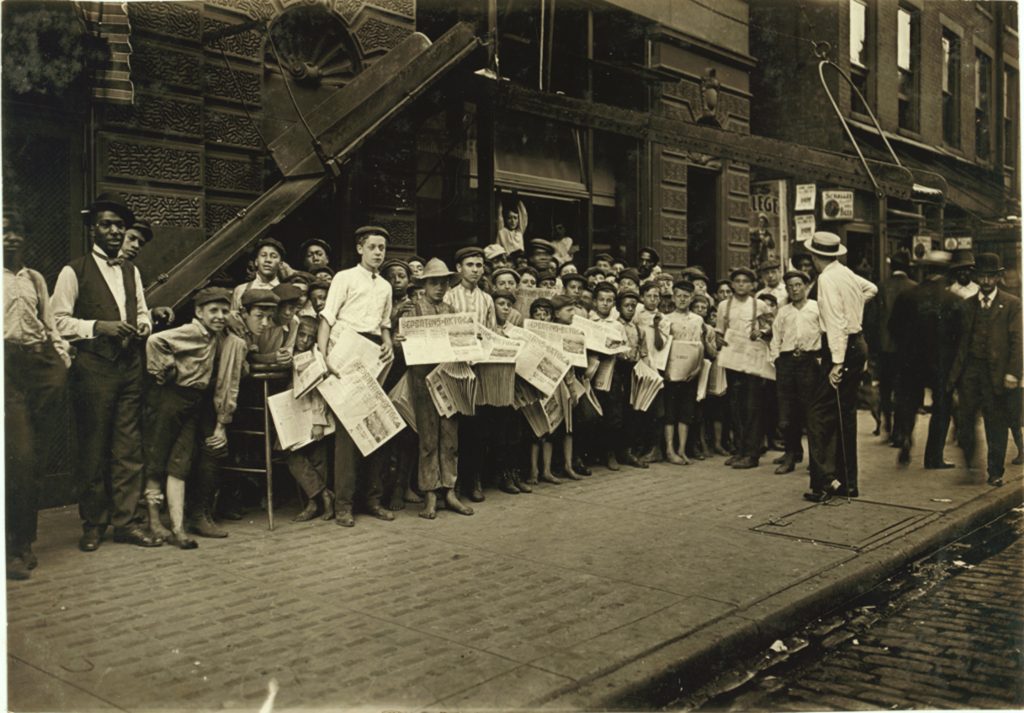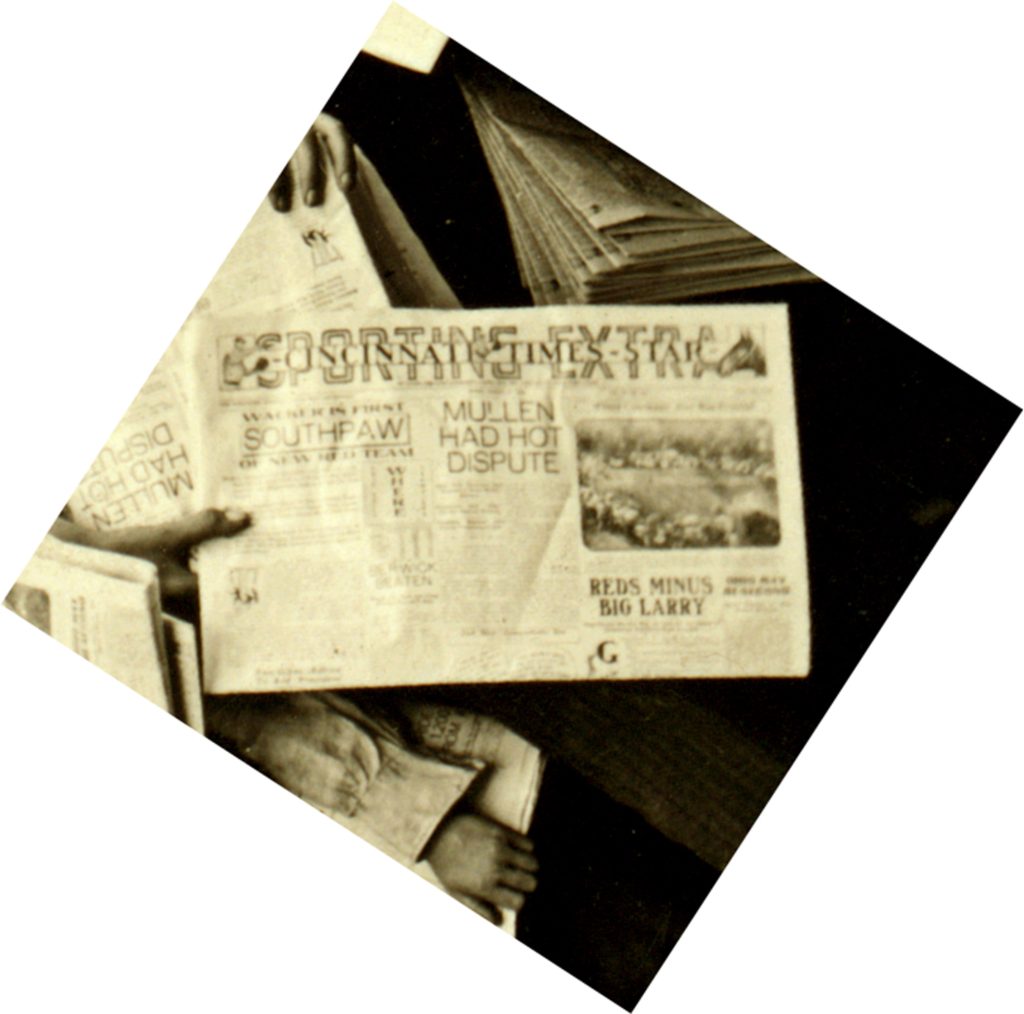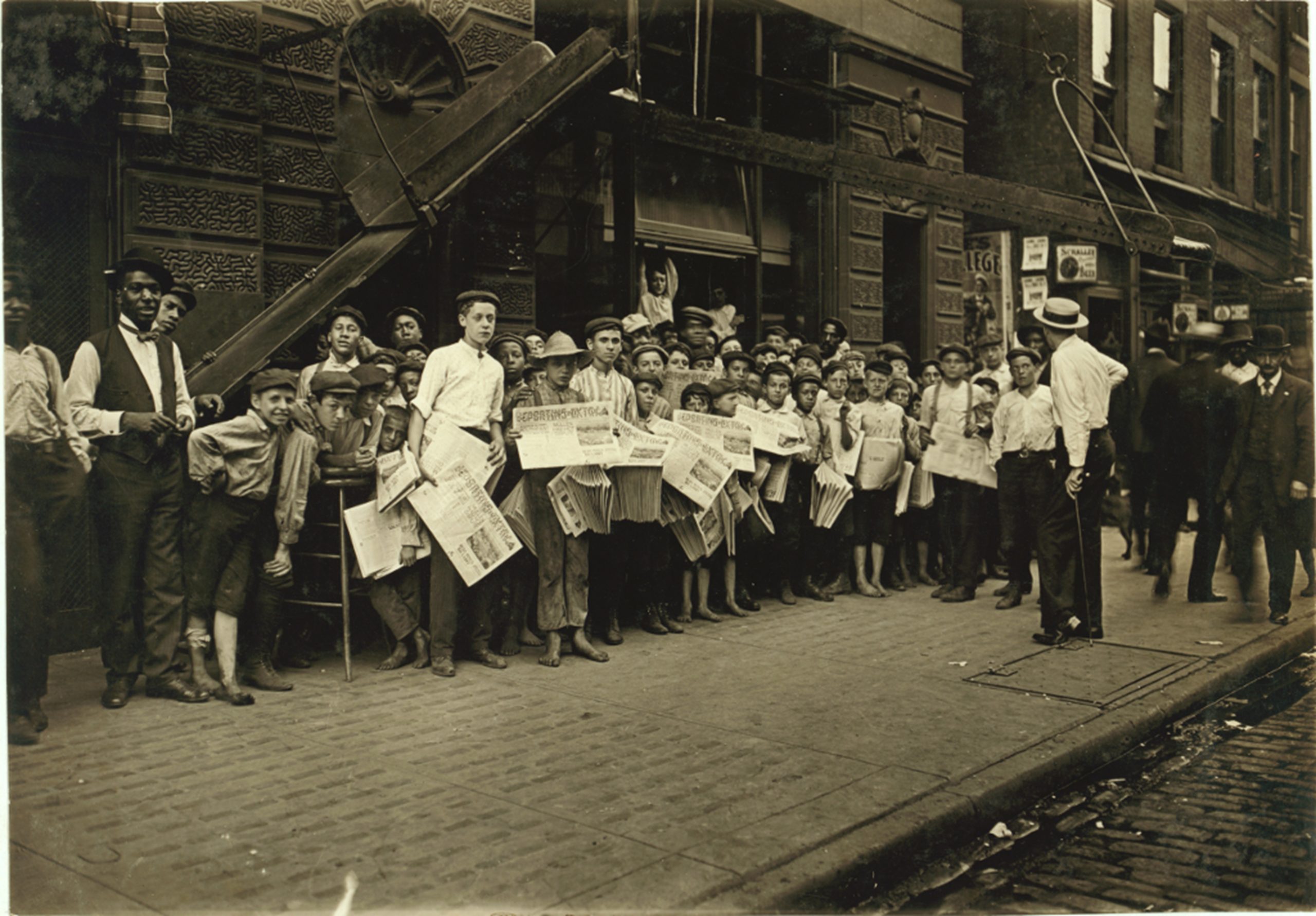Hilary Mac Austin and Kathleen Thompson are the authors of Examining the Evidence: Seven Strategies for Teaching with Primary Sources.
American historian James Harvey Robinson said, “In its amplest meaning History includes every trace and vestige of everything that man has done or thought since first he appeared on the earth.” A Funston Elementary School fourth grader in Chicago put it more simply. “It’s when before happened.”
They’re both right, of course. History is everything that has ever happened before the moment you ask the question. It is Caesar crossing the Rubicon and Washington crossing the Delaware, but it is also you picking up this book, opening it and reading what you’ve read to this point. And now to this point. And now to this point.
That isn’t how most people think of history, of course. Most young students have a vague sense that history is, as one second grader said, “Stuff from back in other days.” Older students, and most adults, may think of history as a timeline, a series of dates and names to be memorized. Or perhaps we think that history is a story, with a beginning and a long, long middle but not, so far, an end.
But the great historical thinker R. G. Collingwood said, “Nothing capable of being memorized is history.” And to think of history as a story leads to expecting it to unfold like a novel or a play, with a plot that makes sense and characters who can be described and known. Stories are much tidier than history, and making history as tidy as a story is a good way to lose its truth.
In fact, history is a process. Just as science is the quest to discover and understand the truth about the world we live in, so history is the quest to discover and understand the truth about our world in the millennia that led up to this moment.
The English word history comes from the ancient Greek word ἱστορία, which means “inquiry, examination, or investigation.” Historians are people who investigate, who dig for clues to our shared past in attics and archives and official records, even in thrift shops. They also interpret and seek to understand what they dig up. That whole process, that ongoing search, is history. It produces articles and books and additions to what has been called the master narrative of the human past, but those things are the products of the historical investigation. History is also the investigation itself.
We asked children who ranged in age from 6 to 12, first grade to sixth, how we know what happened in history. “We read it in our social studies book.” “Some people in the family were there and they told us.” “We read it in a book.” “There are books about it.”
There was no indication in the answers that the students had any idea that historians today might look for and interpret evidence of the past. They were pretty convinced that somebody wrote history down when it happened, and we read it now. That would mean, if it were true, that history was unchangeable, that we could never learn anything new about what happened in our past. That’s not the case at all, of course. We are learning new things about the old days all the time, especially since we have become more aware of the participation and contributions of women, African Americans, American Indians, and other ethnic groups. History is alive.
Thanks to Cosmos and other wonderful science programs, most of us are aware that science has a set of principles and guidelines called the “scientific method.” Similarly, the investigation of history is carried out in accordance with rules and using skills that, together, we call “historical thinking.” We can teach our students this kind of thinking from an early age. And the Common Core State Standards say that we should do just that.
The basis of all historical thinking is simple. As historian Sam Wineburg put it in his foreword to our book Examining the Evidence, “We begin by paying attention. Next, we ask questions.” This is the C3 Framework in action. As students work with primary sources, they are participating in the act of inquiry. They are learning critical thinking skills that they will use all their lives, in college, career, and civic life.
Robin J. Fogarty, Ph.D., one of the authors of How to Teach Thinking Skills Within Common Core (2012), has distilled from the Common Core a list of “21 Explicit Thinking Skills that thread across all content areas for student proficiency.” Of the 21 thinking skills, using the seven strategies we outline below with almost any primary source would ask students to use many or most the following: analyzing, evaluating, generating, associating, hypothesizing, clarifying, interpreting, determining, understanding, inferring, explaining, developing, deciding, reasoning, connecting, and generalizing.
Even in kindergarten, students can begin to examine and gain information from primary sources, just as historians do. With younger students, we suggest working with images and artifacts because we believe that using our strategies with this material will help students not only develop essential visual literacy skills, but also hone key thinking skills that they can later apply when reading text. They will also learn what the historical process is by practicing it themselves. And they can start by looking at a photograph or an old eggbeater.
Seven Strategies for Teaching with Primary Sources
Learn more about these strategies here.
First, let’s look at the seven strategies that we suggest for approaching these primary sources. Then we’ll go on to an example of how teacher Grace Gibbs used some of these strategies in her classroom at Courtenay Language Arts School in Chicago.
Strategy 1: Decide what you’re looking at.
To begin with, are you looking at a primary source at all? Books for children and young adults—even textbooks—are filled with illustrations. Some of those illustrations may have been very carefully created to provide as authentic a picture as possible of a particular time period, situation, or person. That does not make them primary sources, however, and children should gradually learn to recognize this. This doesn’t need to happen in an instant, especially since secondary sources can be useful and appealing ways to introduce students to the world around them and to history. But, over time, students should develop an awareness of the nature of a primary source.
At higher grade levels, this same issue becomes more complex. When you first look at a primary source, you will need to determine, if possible, exactly what it is—what kind of image or text it is, where it came from, and when. Sometimes identifying the material will be as simple as reading a description or a caption in a textbook. Sometimes you may need to do research just to find out what you’re looking at.
Strategy 2: Determine the purpose and audience.
The purpose of a source is usually integrally connected with its intended audience, so determining the purpose often means beginning with the audience. A studio portrait, for example, is usually intended to be given to friends and relatives. The people in the portrait you’re looking at probably wore their best clothes. They posed, or were posed, to look happy or proud or beautiful.
In a documentary photo, on the other hand, the photographer is often trying to get the public to pay attention to something unpleasant, wrong, or painful. The purpose of the photograph does not involve showing its subject in the best possible light. Clearly, we can get different information from a portrait than we can from a documentary photo. The same applies to text. A diary entry gives us different information than a public interview.
Strategy 3: Look for bias.
Looking for bias and understanding how it affects what the text or image communicates is a crucial strategy in viewing a primary source. And bias comes into play on many levels. The personal biases of the author, photographer, or artist are usually reflected in their work. The broader biases of an era or a culture are apparent in almost everything created in and for that era or culture, making it necessary to know some history in order to investigate history.
This strategy helps students develop critical thinking skills that will translate to other areas of their academic lives.
Strategy 4: Examine closely the source itself.
This is, in many ways, the most interesting part of the whole project. It means really looking at all the details of the material carefully and creatively. If dealing with a primary source is detective work, then this is examining the crime scene.
For students in the early grades, this strategy is an excellent exercise for helping to develop visual literacy, whether it is used with a primary or secondary source. When you show students a photograph, for example, and ask them questions that will help them see what’s in it, you are helping them think of visuals as sources of information. They are learning to find and interpret clues to the reality being portrayed. For older students, close examination is the aspect of primary source investigation that gives them the strongest feeling of real participation in the discovery and creation of history.
Strategy 5: Find more information.
If you’re looking at a primary source in a textbook, there may be information in the text that will help you interpret the material. But you and your students may want to know more. A primary source is an extraordinary launching pad for a research project.
And then you go back to the primary source. Your second, more informed look may reveal details you and your students didn’t even notice the first time. It will certainly lead you to different conclusions about some of the things you saw the first time.
Strategy 6: Consider your own role in the interaction.
You and your students bring a whole life’s worth of experience, cultural conditioning, opinions, and biases to the act of viewing a primary source. If you really want to understand what you’re looking at, you need to examine how you’re coloring it. Our expectations are very different from those of people living a century ago, for example. Through discussion, students can compare their own viewpoints with those of people of an earlier time and gain great insight into their own assumptions and prejudices.
Strategy 7: Compare a variety of sources.
By looking at a variety of primary sources, students learn to apply the same basic principles of critical thinking in different ways with different kinds of sources. They learn valuable lessons about point of view and bias. And they get experience in synthesizing and integrating information, a skill that will be of great value when the time comes for them to write research papers.
It’s important to remember that these strategies are not steps that follow one after another. Instead, they provide a framework for a process that is usually a flow rather than a ladder. Analyzing a primary source requires a back and forth between the strategies. “Determining audience and purpose” might be possible only after finding more information. “Examining closely” might occur each time you look at or read the source.
Classroom Example
In 2014, with the help of the Chicago New Teachers Center, we formed a focus group of teachers who wanted to work with primary sources in their classrooms. One of these was Grace Gibbs, who teaches first-grade students at Mary E. Courtenay Language Arts Center in the Uptown neighborhood of Chicago. She has a multi-racial, multi-cultural group of students, mostly Latino and African American.
We asked the focus group to use this photograph with their students:

We provided the teachers with some very basic information about newsboys and about Lewis Hine, the photographer who took this picture. There were thousands of these children—mostly boys but some girls—who sold newspapers on the street. They weren’t employees of the newspapers. They bought the papers and were not allowed to return the ones they didn’t sell, so they usually stayed on the street as long as it took to sell out, which could be more than 12 hours. Many of the “newsies” were homeless and slept on the streets. Others had families that they helped to support. (There’s good information about newsies at The Gilder Lehrman Institute of American History.)

Our focus group teachers shaped their lessons differently, depending on the grade level they were teaching. High school teacher Lindsay Hayden, for example, gave her students no information, not even a caption. She began with Strategy 4. By asking questions and encouraging discussion, Lindsay helped her students determine what was going on in the picture entirely from the evidence in the photograph, zooming in to look closely at details like the headline of the newspaper, which places the newsboys in Cincinnati, Ohio.
Lindsay then went on to Strategy 5, providing historical context, and her students re-examined the photograph in light of that context. (The scaffolding she followed is on our website, OneHistory.org.)
Grace Gibbs, on the other hand, began with Strategy 5, providing her first graders with background information. She told them what newsboys were and the job they did. She went then to Strategy 2, explaining what kind of photograph they were looking at. Then she used Strategy 4, asking the students to examine the photograph closely and tell her about the picture. The results are distilled below.
Grace Gibbs: Who do you see in the picture?
Students: Boys. They are big boys and little boys.
Grace Gibbs: Where are they?
Students: In a city.
Grace Gibbs: Why do you think that?
Students: Because there are tall buildings.
Grace Gibbs: Is it day or night?
Students: It’s day.
Grace Gibbs: Why do you think that?
Students: The sun is shining.
Grace Gibbs: What time of year is it?
One student: Winter.
Grace Gibbs: That’s really interesting. Does anyone else have a different idea?
Other students: Summer.
Grace Gibbs: Why do you think that?
Students: They aren’t wearing jackets.
Grace Gibbs: Was this picture taken now or in the past?
Students: In the past.
Grace Gibbs: Why do you think that?
Students: There isn’t any color. The boys are wearing short pants like we don’t wear.
Even such young students were able to examine a fairly complex primary source and use critical thinking skills to glean information from it. They were able to get a lot of information from the picture and provide their teacher evidence for their conclusions, noticing some things that their teacher hadn’t noticed and, in fact, at least one thing that we had never noticed, even though we’ve looked at the photograph hundreds of times. The students pointed out that the people in the picture were not all looking at the camera.
What they did not notice was also interesting. They didn’t make any mention of the fact that some of the boys were wearing shoes and some were barefoot. And they didn’t mention that some of the boys were white and some African American. The older students noticed both of these facts and speculated about them. This speculation led to discussions of class, race, geography, and history.
So, how does this exercise with the image of the newsboys relate to the Common Core State Standards? Both sets of students—those in first grade and those in high school—used numerous skills called out in the Common Core. Every participating student used CCSS Anchor standards. They read [viewed the image] closely and made logical inferences from it and they cited specific evidence to support their conclusions (CCSS.ELA-Literacy.CCRA.R.1). They evaluated content presented in diverse media and formats, including visually (CCSS.ELA-Literacy.CCRA.R.7).
The first grade students also used Reading: Informational Text standards. These same standards—growing in complexity—would apply to any of the elementary grades. Students asked and answered questions about key details in a text [image] (CCSS.ELA-RI.1.1). With the help of their teacher, they identified the main topic of the text [image] and retold key details about it (CCSS.ELA-Literacy.RI.1.2). They used a caption the teacher read to them (CCSS.ELA-Literacy.RI.1.5) [1]. Finally, they began the process of distinguishing between information provided by pictures and information provided by the words in a text (CCSS.ELA-Literacy.RI.1.6).

A number of other standards could also be applied to the examination of this image for students at higher grades, including interpreting information presented visually (CCSS.ELA-Literacy.RI.4.7); explaining how an author [photographer] uses evidence to support particular points (CCSS.ELA-Literacy.RI.4.8); determining an author’s [photographer’s] point of view or purpose (CCSS.ELA-Literacy.RI.6.6); and comparing and contrasting two texts [or a text and an image] on the same topic (CCSS.ELA-Literacy.RI.6.9). Examining this image, this primary source evidence of the past, demanded key critical thinking skills called out in the Common Core, but, just as important, it gave both the older and the younger students a sense of how historians work with the clues of history. Working with primary sources is excellent training in critical thinking. Once students have learned to interpret and evaluate primary sources, they can use the same skills when listening to a news show, reading a book or magazine, or, perhaps most important, looking at the Internet. While they’re learning about history and the world around them, they will also learn to be thinking, questioning people and citizens.
[1] This standard refers to text features generally. Captions aren’t specifically called out until the Grade 2 iteration of this standard.



